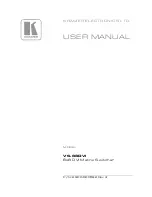
Section 5
Remote commands
In this section:
Introduction to remote operation ................................ 5-1
About ICL commands................................................. 5-4
Overview of instrument drivers................................. 5-18
Migrating from Models 707A and 708A .................... 5-21
Introduction to remote operation
Keithley Instruments Test Script Processor-enabled instruments operate like conventional instruments
by responding to a sequence of commands sent by the controller. You can send individual commands
to the TSP
®
-enabled instrument.
Unlike conventional instruments, TSP-enabled instruments can execute automated test sequences
independently, without a controller. You can load a series of instrument control commands into the
instrument and store these commands as a script that can be run later by sending a single command
message to the instrument. You do not have to choose between using “conventional” control or
“script” control. You can combine these forms of instrument control in the way that works best for your
particular test application.
Controlling the instrument by sending individual command messages
The simplest method of controlling an instrument through the communication interface is to send it a
message that contains instrument control commands. You can use a test program that resides on a
computer (the controller) to sequence the actions of the instrument.
Instrument control commands can be function-based or attribute-based. Function-based commands
are commands that control actions or activities. Attribute-based commands define characteristics of
an instrument feature or operation.
















































